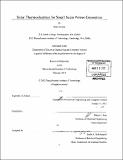| dc.contributor.advisor | Rajeev J. Ram. | en_US |
| dc.contributor.author | Amatya, Reja | en_US |
| dc.contributor.other | Massachusetts Institute of Technology. Dept. of Electrical Engineering and Computer Science. | en_US |
| dc.date.accessioned | 2012-05-15T21:12:13Z | |
| dc.date.available | 2012-05-15T21:12:13Z | |
| dc.date.copyright | 2012 | en_US |
| dc.date.issued | 2012 | en_US |
| dc.identifier.uri | http://hdl.handle.net/1721.1/70784 | |
| dc.description | Thesis (Ph. D.)--Massachusetts Institute of Technology, Dept. of Electrical Engineering and Computer Science, 2012. | en_US |
| dc.description | Cataloged from PDF version of thesis. | en_US |
| dc.description | Includes bibliographical references (p. 243-253). | en_US |
| dc.description.abstract | In the past two decades, there has been a surge in the research of new thermoelectric (TE) materials, driven party by the need for clean and sustainable power generation technology. Utilizing the Seebeck effect, the thermoelectric devices can be used as heat engines to convert heat into electricity. With no moving parts, the generators are considered highly reliable with low maintenance, which is essential for decentralized power source. With nearly 1.6 billion people living without basic electricity, the need for a small scale power generation is there. Through this work, we show that the solar thermoelectric generators (STEGs) using cheap parabolic concentrators with high ZT modules can be a viable and a costeffective alternative to solar photovoltaics for distributed power generation. The maximum conversion efficiency of 3% has been achieved for a STEG under AM 1.5G conditions with commodity thermoelectric module. The generator was able to produce a peak output power of 11 W, with an inexpensive parabolic solar concentrator which can be found in developing countries being used as solar cookers. The output power is the highest achieved value for concentrated solar thermoelectrics and it is comparable to photovoltaic modules that are deployed in these rural communities. Based on a heat transfer model developed during this work, various system parameters were analyzed for maximizing the performance. An optimized thermoelectric module design with a slight aspect ratio variation for the TE legs have been identified that can increase the efficiency by 28%. Another parameter for system improvement that has been considered is the use of novel TE material. Issues of earth-abundance, material scarcity and cost have been taken into consideration for new material. These are important considerations for a technology that can have a potential cost-effective large scale deployment. A robust, high temperature thermoelectric material characterization tool (Z-meter) has been developed with proper radiation suppression (20x below black body radiation) and low system parasitics (41.6% lower electrical contact parasitic that previous published results). We investigated novel metalsemiconductor superlattice structures ((HfZr)N/ScN) using the Z-meter setup. Low thermal conductivities (2.5-5 W/m.K) have been measured for temperature range of 300-650 K. The Seebeck coefficient of 132 [mu]V/K was measured at 830 K, which is comparable to the state-of-the-art SiGe at similar temperature. | en_US |
| dc.description.statementofresponsibility | by Reja Amatya. | en_US |
| dc.format.extent | 253 p. | en_US |
| dc.language.iso | eng | en_US |
| dc.publisher | Massachusetts Institute of Technology | en_US |
| dc.rights | M.I.T. theses are protected by
copyright. They may be viewed from this source for any purpose, but
reproduction or distribution in any format is prohibited without written
permission. See provided URL for inquiries about permission. | en_US |
| dc.rights.uri | http://dspace.mit.edu/handle/1721.1/7582 | en_US |
| dc.subject | Electrical Engineering and Computer Science. | en_US |
| dc.title | Solar thermoelectrics for small scale power generation | en_US |
| dc.title.alternative | Solar TEs for small scale power generation | en_US |
| dc.type | Thesis | en_US |
| dc.description.degree | Ph.D. | en_US |
| dc.contributor.department | Massachusetts Institute of Technology. Department of Electrical Engineering and Computer Science | |
| dc.identifier.oclc | 792741701 | en_US |
